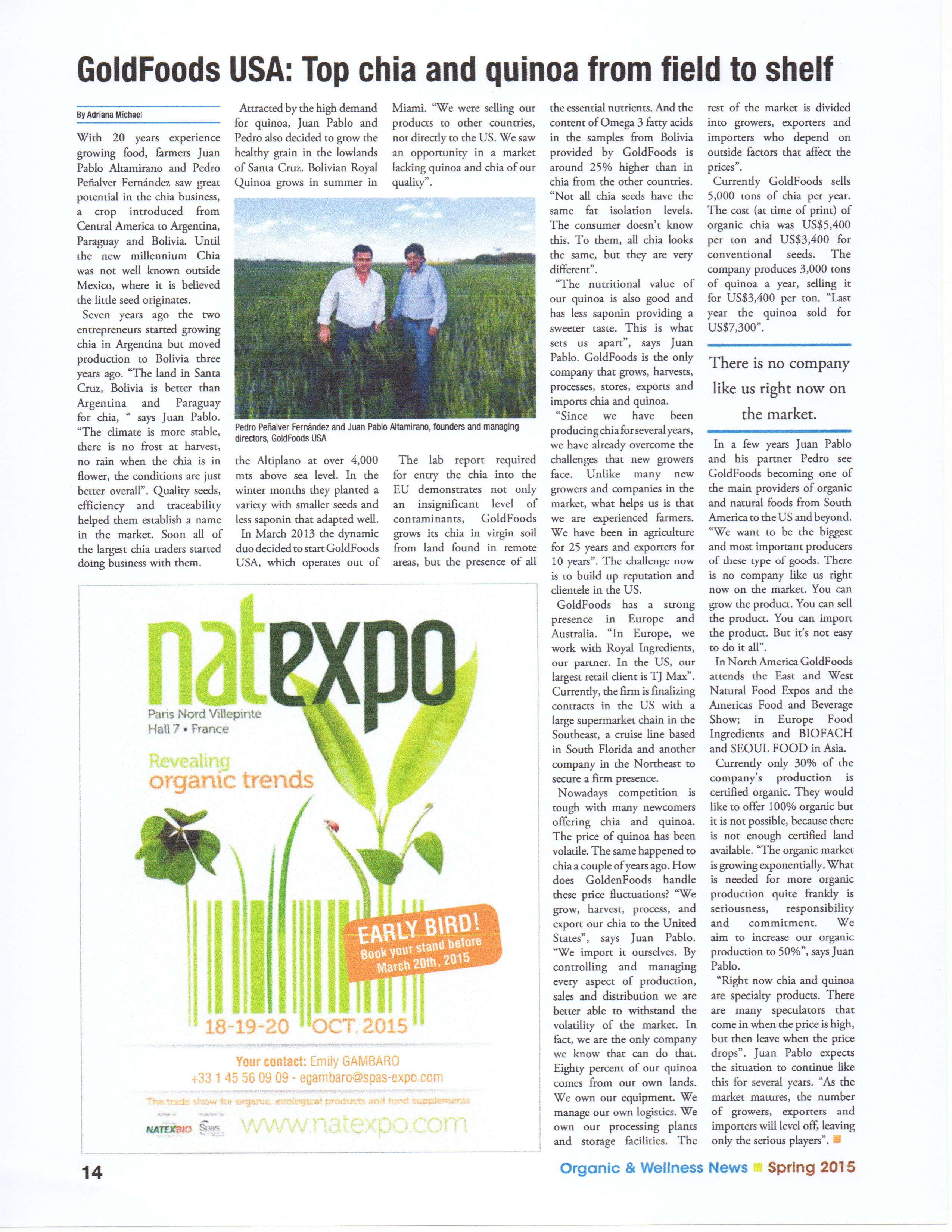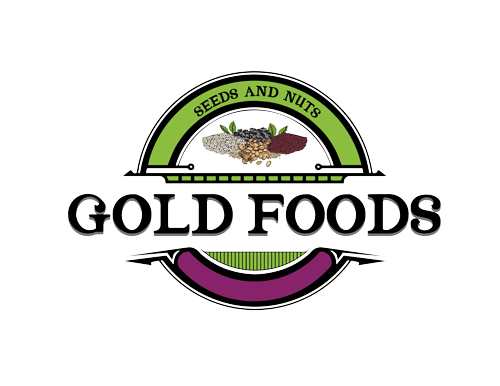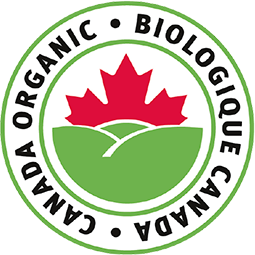
08 Feb Gold Foods USA: From Field to Shelf
Read about our founders and the quinoa and chia business in the latest issue of Organic Wellness News. (page 14)
Read more: Full Organic Wellness News
Full Article in Organic Wellness News By Adriana Michael
With 20 years experience growing food, farmers Juan Pablo Altamirano and Pedro Peñalver Fernández saw great potential in the chia business, a crop introduced from Central America to Argentina, Paraguay and Bolivia. Until the new millennium Chia was not well known outside Mexico, where it is believed the little seed originates.
Seven years ago the two entrepreneurs started growing chia in Argentina but moved production to Bolivia three years ago. “The land in Santa Cruz, Bolivia is better than Argentina and Paraguay for chia, “ says Juan Pablo. “The climate is more stable, there is no frost at harvest, no rain when the chia is in flower, the conditions are just better overall”. Quality seeds, efficiency and traceability helped them establish a name in the market. Soon all of the largest chia traders started doing business with them.
Attracted by the high demand for quinoa, Juan Pablo and Pedro also decided to grow the healthy grain in the lowlands of Santa Cruz. Bolivian Royal Quinoa grows in summer in the Altiplano at over 4,000 mts above sea level. In the winter months they planted a variety with smaller seeds and less saponin that adapted well. In March 2013 the dynamic duo decided to start GoldFoods USA, which operates out of Miami. “We were selling our products to other countries, not directly to the US. We saw an opportunity in a market lacking quinoa and chia of our quality”.
The lab report required for entry the chia into the EU demonstrates not only an insignificant level of contaminants, GoldFoods grows its chia in virgin soil from land found in remote areas, but the presence of all the essential nutrients. And the content of Omega 3 fatty acids in the samples from Bolivia provided by GoldFoods is around 25% higher than in chia from the other countries. “Not all chia seeds have the same fat isolation levels. The consumer doesn’t know this. To them, all chia looks the same, but they are very different”.
“The nutritional value of our quinoa is also good and has less saponin providing a sweeter taste. This is what sets us apart”, says Juan Pablo. GoldFoods is the only company that grows, harvests, processes, stores, exports and imports chia and quinoa.
“Since we have been producing chia for several years, we have already overcome the challenges that new growers face. Unlike many new growers and companies in the market, what helps us is that we are experienced farmers. We have been in agriculture for 25 years and exporters for 10 years”. The challenge now is to build up reputation and clientele in the US.
GoldFoods has a strong presence in Europe and Australia. “In Europe, we work with Royal Ingredients, our partner. In the US, our largest retail client is TJ Max”. Currently, the firm is finalizing contracts in the US with a large supermarket chain in the Southeast, a cruise line based in South Florida and another company in the Northeast to secure a firm presence.
Nowadays competition is tough with many newcomers offering chia and quinoa. The price of quinoa has been volatile. The same happened to chia a couple of years ago. How does GoldenFoods handle these price fluctuations? “We grow, harvest, process, and export our chia to the United States”, says Juan Pablo. “We import it ourselves. By controlling and managing every aspect of production,sales and distribution we arebetter able to withstand the volatility of the market. In fact, we are the only company we know that can do that. Eighty percent of our quinoa comes from our own lands. We own our equipment. We manage our own logistics. We own our processing plants and storage facilities. The rest of the market is divided into growers, exporters and importers who depend on outside factors that affect the prices”.
Currently GoldFoods sells 5,000 tons of chia per year. The cost (at time of print) of organic chia was US$5,400 per ton and US$3,400 for conventional seeds. The company produces 3,000 tons of quinoa a year, selling it for US$3,400 per ton. “Last year the quinoa sold for US$7,300”.
In a few years Juan Pablo and his partner Pedro see GoldFoods becoming one of the main providers of organic and natural foods from South America to the US and beyond. “We want to be the biggest and most important producers of these type of goods. There is no company like us right now on the market. You can grow the product. You can sell the product. You can import the product. But it’s not easy to do it all”.
In North America GoldFoods attends the East and West Natural Food Expos and the Americas Food and Beverage Show; in Europe Food Ingredients and BIOFACH and SEOUL FOOD in Asia.
Currently only 30% of the company’s production is certified organic. They would like to offer 100% organic but it is not possible, because there is not enough certified land available. “The organic market is growing exponentially. What is needed for more organic production quite frankly is seriousness, responsibility and commitment. We aim to increase our organic production to 50%”, says Juan Pablo.
“Right now chia and quinoa are specialty products. There are many speculators that come in when the price is high, but then leave when the price drops”. Juan Pablo expects the situation to continue like this for several years. “As the market matures, the number of growers, exporters and importers will level off, leaving only the serious players”.



